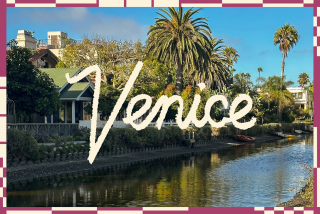The Wall Street of 16th-Century Venice : THE GHETTO OF VENICE <i> by Riccardo Calimani, translated by Katherine Silberblatt Wolfthal (M. Evans: $19.95; 400 pp.) </i>
- Share via
Although its population never exceeded 5,000, the Jewish community of Venice achieved an importance far greater than these numbers would suggest. It was Venice, after all, that created the first ghetto in 1516 when it designated a specific district for the Jews in a neighborhood known as the “foundry” or, in Venetian dialect, getto or ghetto.
While the ghetto became a universal symbol of segregation, at the time of its establishment it was regarded by the Venetians as a major concession to the Jews, who up until then had been excluded entirely from the city. The Venetian Senate decided to invite Jewish money-lenders from nearby Mestre and Murano for a specific economic purpose: to provide capital for the city’s far-flung Mediterranean commerce and to help fund its costly wars to keep those trade routes open.
Riccardo Calimani’s newly published “The Ghetto of Venice” reminds us of the extent to which Jewish life in Venice--as in the rest of Europe--was shaped by the economic and social needs of the surrounding society. The heavy concentration of Jewish bankers in Venice--caricatured by William Shakespeare in the figure of Shylock in “The Merchant of Venice”--was not due to some instinctive attraction on the part of Jews to moneylending but the direct result of elaborate legislation that made it virtually impossible for them to do anything else. The Jews of Venice could not own land and for many years were banned from all kinds of commerce and business other than dealing in secondhand clothing.
Catholic doctrine prevented Christians from lending money at interest but did not prohibit Jews from doing so. Consequently, many Renaissance city-states brought in Jews to stimulate trade and expand credit, but during fits of religious revivalism Catholic preachers would inveigh against usury as the source of all evil and the moneylenders would be subject to violent popular attacks or banishment. Venice also vacillated between relative tolerance and sudden backlashes of anti-Semitism, often in response to swings in the Republic’s uneasy relations with the Vatican. Innumerable times the Venetian senate ordered the expulsion of the Jews, only to revoke the edict at the last minute. But as an independent and business-minded state, Venice protected its Jews more than most.
In 1541, for example, the “Most Serene Republic of Venice” shrewdly invited Jewish merchants who had been expelled from Spain in 1492 to trade in the city. Venice understood that it needed to reverse the economic decline that had begun with the discovery of the New World and the expansion of trade on the Atlantic Ocean. Indeed, these Jewish merchants, who had settled all around the rim of the Mediterranean, opened up rich new trading possibilities, especially with the Ottoman Empire. Venice later gave safe passage to a second group of immigrants, the Marranos, Spanish and Portuguese Jews who had initially remained in their countries during the Inquisition and had been forcibly converted to Christianity.
Most Marranos led a double life--outwardly Christian, privately Jewish--and were viewed with suspicion by Jews and Christians alike. Calimani includes a fascinating chapter that summarizes trials in which the authorities attempted to deal with the theological complications presented by the Marranos. Eventually, Venice allowed Marranos to convert back to Judaism if they wished.
This influx of immigrants from all over stimulated a rich cultural as well as commercial revival. Although Jews were not allowed to own printing presses, the Christian publishers of Venice printed a wide range of Jewish authors, attracting scholars from across Europe. As Venice permitted more contact between Jews and Christians, a rich cross-pollenation between Jewish scholarship and Renaissance humanism occurred. Not only did humanists begin to study the tradition of the Jewish cabala, Venetian Jews began to explore beyond religion into the areas of music, poetry and drama.
At the same time, in their everyday life the Jews of the ghetto developed a deep affection for their city and incorporated its customs into their own. “On the feast of Purim, in emulation of the famous Venetian Carnival, the Jews dressed up in masks and disguises,” Calimani notes. He also tells the story of a famous Venetian rabbi who invents a theological justification for allowing Jews to watch a Venetian regatta on a Jewish holiday.
At moments, Calimani’s historical presentation bogs down in a recitation of facts and dates, but he enlivens the history considerably by including chapters on representative figures of Venetian Jewish history: Leone da Modena, a rabbi who wrote poetry and loved gambling and music; Daniel Rodriga, a Marrano merchant who convinced Venice to let him build the port of Spalato; and Moses Zacuto, known as the “Jewish Dante” for his 17th-Century epic poem about a journey to Hell.
Although the book ranges from the beginnings of the ghetto to the present, it concentrates almost exclusively on the period from 1516 to 1700. Calimani races through the last 287 years of the Venice ghetto in less than 60 pages. The emphasis is not entirely misplaced: The vitality of the city’s ghetto was closely linked to the fortunes of Venice itself. In the 18th Century the ghetto fell into torpor as Venice declined. By the time the Venetian Republic collapsed under the invasion of Napoleon in 1797, the ghetto was a comparatively poor community of only 1,600 souls. Calimani might have done well, however, to give us more on the 20th Century--especially the Fascist era and the period of Nazi occupation--to which he dedicates only six pages. The author seems to note the deficiency by apologetically naming the last chapter “The 20th Century: A History Yet to Be Written.” Nonetheless, the book remains a solid introduction to a fascinating subject.
More to Read
Sign up for Essential California
The most important California stories and recommendations in your inbox every morning.
You may occasionally receive promotional content from the Los Angeles Times.













